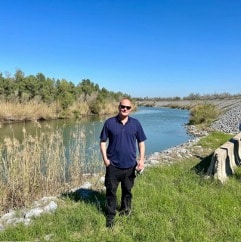Note: This is the first article in a three-part series involving my visit to the southwest border of the U.S. in February 2024.

For the past five years, I have been involved in human trafficking research and training. I have spent a significant amount of time conducting in-country research and training on human trafficking in both Central America and South America.
I’ve studied trafficking and smuggling routes through these regions that traffickers use to lead victims to our southwest border. I have also spoken with countless human trafficking victims and former human traffickers in Central America who were either previously or currently incarcerated.
In the United States, I have spent many years in federal law enforcement. I was involved in interdiction, counter human trafficking and anti-smuggling work in Miami, Florida.
Like most people, I have seen the media reports and images of what is going on at the southwest border of the U.S. However, I did not fully understand the true scope of the problem.
That understanding changed during the week of February 19, 2024. I spent a week conducting human smuggling and human trafficking research on the southwest border.
What I learned was horrifying.
The Difference Between Human Smuggling and Human Trafficking
To fully understand the situation at the southwest border of the U.S., it is essential to understand the difference between human smuggling and human trafficking. Both crimes are billion-dollar industries for cartels.
Human smuggling is transportation-based. Migrants pay cartels and coyotes (human smugglers who serves as guides and informants for cartels) to be illegally transported to the U.S. for a high price.
Human trafficking is labor-based. Its victims are exploited and forced to do some type of labor against their will.
At the southwest border, it is common for a victim to pay in order to be smuggled illegally into the United States. However, many would-be migrants are forced into human trafficking, especially when cartels have a specific use for those people.
If cartel members discover that certain migrants have a useful skill – such as being tech-savvy –then the cartel may decide not to let those migrants go once they reach the border. Migrants can also be forced into human trafficking when they don’t have the money for unexpected expenses during the trip. Females are commonly coerced into sex trafficking, and males are commonly forced into drug packaging.

My week began with an informative tour consisting of influencers, the media, and other people who met in McAllen, Texas. The trip started along the border wall on the U.S. side and went along the Rio Grande River.
During the tour, I noticed remnants of what looked like a migrant camp in the bushes on the Mexican side. This area is commonly used as a staging ground. Guided by smugglers, migrants typically leave these areas to cross the U.S.-Mexico border at night, when there is less chance of detection.
Part of the tour included visiting a shelter that housed people who were trafficked and smuggled across the border. The people in this shelter had been cleared by Border Patrol to enter the United States. They likely had a future court date, which could be four to seven years in the future.
Speaking with Victims of Unspeakable Exploitation
I had the opportunity to speak directly with some of the migrants, and their stories were devastating.
One person I met was named Alan. Alan and his family were from Peru, and they were smuggled into the United States by cartel members.
When they went through the violent Darien Gap, they were robbed at gunpoint by members of the Sinaloa Cartel. After that, the family was smuggled to Reynosa, Mexico.
After his arrival in Reynosa, Alan and the rest of his family were transferred to what he called the “Scorpion Cartel.” In that region, the Gulf Cartel controls the smuggling route, so the Gulf Cartel and the Scorpion Cartel may be the same organization.
In any case, Alan was robbed at gunpoint again by the second cartel. I asked for pictures of his journey to the border, but his phone had been stolen. Luckily, they survived because Alan’s family sent him money via Western Union.
I talked with another man who was from Venezuela and who had also passed through the Darien Gap. While in the Darien Gap, he saw two people get raped and murdered because they did not have the money to bribe cartel members.
Bribes Make the Difference Between Life and Death for Migrants En Route to the Southwest Border
During this border visit, I learned that migrants illegally give coyotes and smugglers all of their money upfront. During the journey or when they are robbed, migrants depend on family members, either in the U.S. or their home country, to send them money via Western Union.
In addition to bribes, migrants often have to pay extra for unexpected delays, due to weather or other factors. They may also need additional money needed to pay off corrupt border officials in the foreign countries through which they travel on their way to the United States. Anyone who does not have family members who can send money is commonly killed.
In many cases, children from families are kidnapped by the cartel as payments. What happens to those children is unclear, but they are likely sold into sex trafficking or become the victims of organ trafficking.
Sadly, there is a market for juvenile organs. I learned about one particular trafficker named Turco, who was known for harvesting child organs. The last known case involved a 12-year-old who had his left eye harvested for $15,000 in Mexico.
Perhaps the most disturbing story I heard was about a mother who illegally came to the United States. While she was at the shelter, she refused to put down her child.
When the shelter’s staff asked why she didn’t want to let go of her child, the mother stated the child was all she had left. The mother explained that she had been robbed on a train en route to Reynosa.
In addition to taking all of her belongings, the thieves kidnapped her other two children. She has no idea where her kidnapped children are now located.
There were other migrants who experienced unspeakable trauma, due to the callous nature of cartel members. To maintain control of a migrant group, a common intimidation tactic is for cartel members to sexually assault victims in front of their families.
The Media Has Failed to Tell the Whole Story of the Southwest Border Crisis
The situation at the southwest border of the U.S. is much, much worse than what the world’s media reports. The news media has failed to capture the true stories of the victims.
The crisis at our southwest border cannot be a mere political issue. The number of people trafficked and smuggled to the border is occurring at alarming amounts.
One former human trafficker told me that everyone is getting involved in human trafficking right now because it is so profitable. When I asked, “Why now?”, that trafficker said that due to the open borders policy, the ease of gaining amnesty, and the acceptance of illegal entry into the United States, cartels have made record profits.
After the week-long border visit was over, I traveled into Mexico to see two different border crossings and spoke directly with migrants on the Mexican side. What I learned in Mexico was equally astounding and will be covered in future articles in this series.
The purpose of writing these articles and creating my video is to bring awareness to this crisis at our southwest border. Currently, I am traveling the country speaking to organizations and groups about the scope of human trafficking in the United States and what everyone can do to mitigate this crime.
Anyone interested in learning more about the training opportunities involving human trafficking I provide can reach me at jarrod.sadulski@mycampus.apus.edu.

Comments are closed.